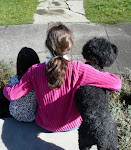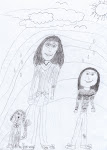
My daughter clears her dinner dish and skips over to the fruit bowl to pick out a banana. Cracking the tip, she slowly draws back the peel, section by section, then stops to study the flowering banana. She looks up at me and an impish smile spreads across her face. Lifting a dangling piece of peel between thumb and forefinger, she holds it out . Turning her head to one side, tilting her nose up, she commences to waltz about the kitchen – with her banana.
She can’t
not dance.
She’s in constant motion these days. Everything seems a cause for celebration. She’s testing her wings, discovering new gifts in every direction.
She loves school, math, science, humanities, art, music and of course, best of all, recess, and friends. Last year she joined her school soccer team but merely danced and bobbed at a healthy distance away from the ball while her teammates scrambled. But this year, she’s scrambling, scrimmaging, kicking, and scoring. She also plays goalie. Two weeks ago, an attacker broke free and raced down the field. My daughter calmly planted her feet and stared at the girl. When the shot came, it hit my daughter square in the chest. Her arms wrapped reflexively about the ball. She looked stunned, but then broke into a grin, rocked back on her heels, and drummed the ball with her fingers as if to say,
No worries my pretty. She then proceeded to strut up and back in front of the goal, cradling her prize, pumping her fist.
The ref had to remind her to throw the ball back in play.
She’s developing a sense of herself, her power, her abilities. She’s feeling good and yet, I know, challenges await.
Since viewing
Adopted, I’ve been reading. I read Helen Zia’s
Asian American Dreams: The Emergence of an American People, and
Yell-Oh Girls by Vickie Nam. I’ve begun following blogs like
AdoptionTalk,
Adopt-a-tude,
Harlow’s Monkey,
Anti-Racist Parent, and
Angry Asian Man.
I understand all too well now there will be those who will try to write my daughter’s narrative for her, pegging her as the smart minority, the geeky minority, the exotic female, the unwanted daughter, the perpetual foreigner, or worse, the spy. I’ve read the stories. I’ve heard the comments.
My goal now is to equip my daughter as best as I can. To bolster her self esteem. To give her a strong --
dare I say, rock solid? -- sense of herself and her rightful place in the world.
It’s not enough to connect her with her heritage through books, holidays, language, art, and dance. She needs to connect and identify with other Asian American (as well as Euro-American) friends, kids, adoptees, and adults. She needs healthy role models. She also needs positive images reflected back at her from the mix of media around her.
I conduct a silent audit.
We live in a city with a relatively healthy Asian American population. We’re surrounded by numerous, varied, highly accomplished Asian Americans, civic leaders, journalists, doctors, lawyers, engineers, academics, legislators, and politicians. 20% of my daughter’s 4th grade class is Asian American. Within a quarter mile radius of our home, we know no less than 6 Chinese daughters, born in China, adopted and growing up here, full-fledged American citizens. Our city enjoys a thriving, active, organized group of Families with Children from China. My daughter’s best neighborhood friend – through pure serendipity – is Japanese American. The girl's parents are distinguished physicians and academics. My daughter's dentist, orthodontist, one of her teachers, one of her coaches, are or, have also been, of Asian descent. It’s not something I’ve focused on falsely or deliberately, but we also know and are friends with a number of mixed race families, some by marriage, some by adoption, some by both.
At least in our friendships, our community, and the broader world in which we circulate, my girl has a relatively varied view before her. But, what about images in the media? In the books we read? In the films we watch?
When she was a toddler, we had a wealth of picture books to draw from that reflected our world, her heritage, or parts of our story.

But now, my daughter’s at a different age, with different needs. She needs youthful heroines she can relate to. She reads a lot and we watch the occasional movie, though she’s always been highly sensitive. So much so, that most of Hollywood’s fare has proven too violent. Over the years, we’ve taken refuge in the "classics." The books I grew up with. But, how well do these classics reflect a healthy reality for her? I survey my daughter’s bookcase along with our video and DVD collection.
It's a wake-up call.

How many white, English, blond, or red-headed heroines can my daughter take? You know.. the girls with the alabaster skin, apple-colored cheeks, lush golden, or auburn colored curls, or worse, the stereotypically
large, round eyes, that blaze blue as sapphires? There’s a brunette in there but, please... how many of us look like Elizabeth Taylor?
The results of my audit propel me to action. I scour Blockbuster for a movie with a young Asian heroine -- but find nothing. I find a small, retro, independent rental store with a broader, deeper selection of American as well as foreign and old movies. It takes me 40 minutes to find a single reason to hope. I vaguely remember seeing
Not One Less from my pre-parenting days. I sign it out and take it home.
 Not One Less
Not One Less is the story of a 13 year old girl from China’s countryside who’s recruited to serve as a substitute teacher in a crude one room classroom. When one of her many unruly charges is sent to the big city to earn a wage for his family, she goes to heroic lengths to rescue him off the streets. The scenery is breath-taking. The characters, inspiring.
My daughter doesn’t even balk at the sub-titles. Instead, she exclaims, “I can make out some of the Chinese words, Mom!”
More noticeable still is her chatty, open reaction to the characters.
"Look Mom! Isn't she beautiful?!"
"Isn’t she pretty?!” "Oh! The kids are so cute!"
“Wow, she’s really determined. I can be determined like that.”
"I love this film, Mom. Can we do more movies like this?"
As I shut off the DVD player, I direct my daughter to head upstairs and get ready for bed while I finish up in the kitchen. When I turn to make my ascent up the stairs, I find my daughter waiting for me, standing at the top of the landing.
“That movie was a
TEN, Mom!”
Wow. I think.
Note to self... I need to find more movies like this one.
I go to bed with a small sense of victory. The next day, I sign up for Netflix and spend time digging about for movies like
Not One Less.

A few days later my daughter arrives home from school and I show her the red envelope containing:
The Road Home.
She gushes. “Oh Mom! If it’s a Chinese film, it’s got to be good!”
She can’t wait to watch it and indeed the movie proves beautiful. Epic, allegorical, and tragic -- in a gentle, romantic, kind of way -- it's the story of a country girl who falls deeply in love with a newly arrived young teacher. Accused of "Rightest" tendencies, he is summoned away to the city. The country girl waits stoically in the freezing cold snow, hour after hour, day after day, anticipating his return. But he is detained and she falls desperately ill. Word reaches the teacher and he sneaks back to be by her side only to be punished by the authorities. The two must wait several more years while he is further detained in the city.

The movie stars the luminous Zhang Ziyi, and the strikingly handsome Zheng Hao, and it's all shot against a backdrop of sweeping mountain scenery, deep in the Chinese hinterland.
My daughter loves it.

Next we try
The King of Masks, a story of poverty and struggle from the 1930’s. An old magician street performer bemoans his fate in having no son to whom he can pass on his ancient art. He buys a child on the black market. But the child is a girl disguised as a boy. The man and girl develop a bond, but her secret is exposed and there are tragic results. The characters face loss, destitution, abuse, and a brush with death before finally realizing they can make a life together.
The story is difficult. Too difficult. I press the mute button a lot but we’re both unsettled and in tears over the heart wrenching drama. I apologize. Together, we agree the choice wasn't the best.
Oops…
I scan the Chinese section in Netflix once more but there are so many films filled with martial arts, swords, daggers, and bloodshed. And then there’s the porn. Lots of porn, portraying Asian women as exotic …
er… um… play things.
Time for a documentary, maybe?

My efforts here prove fruitful. I discover the BBC’s 2008 production,
Wild China. The two disk series offers more than 6 hours of National Geographic-like footage of China. It’s an incredible survey of China’s vast, unique landscapes, it's remote mountains, rivers, flood plains, and deserts. It features some of China’s most amazing, most unusual wildlife, and includes the story of several local peoples, traditions, and cultures.
The documentary is a hit. We share several nights curled up under a blanket “ooh-ing” and “ahh-ing” over China’s riches.
Now, when we’re not viewing an installment of
Wild China, my daughter and I curl up together to read and enjoy another new favorite: “
Tales of a Chinese Grandmother,” a book I found rummaging about our local Chinatown. In the meantime, our “Netflix Queue” has grown. It now includes not only tales and documentaries from China, but children’s stories from around the world.
Are my efforts making a difference? I think so. I hope so.
A few months ago, we discovered my daughter is lactose intolerant. The other day, as she helped entertain a friend and serve up some lunch, she offered, “Sorry. We don’t have milk at our house any more. Would you like some water?” Her friend was unfazed by the news, but my daughter seemed eager to explain: “I’m lactose intolerant.”
It sounded like she was boasting -- which puzzled me. Until she added:
“It’s really a common thing you know. Among Asians. I’m Asian.”

Got any film or book recommendations to share? I'd love it if you shared them. Just click on the "comments" link below.













 The movie stars the luminous Zhang Ziyi, and the strikingly handsome Zheng Hao, and it's all shot against a backdrop of sweeping mountain scenery, deep in the Chinese hinterland.
The movie stars the luminous Zhang Ziyi, and the strikingly handsome Zheng Hao, and it's all shot against a backdrop of sweeping mountain scenery, deep in the Chinese hinterland. 

